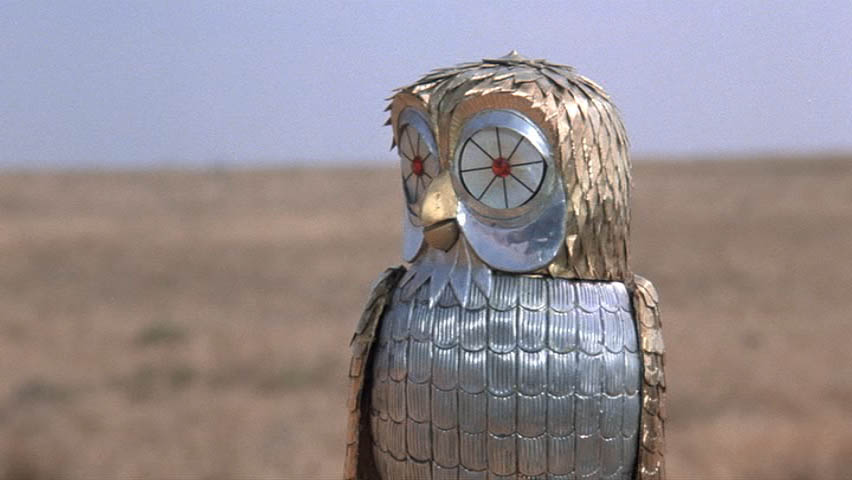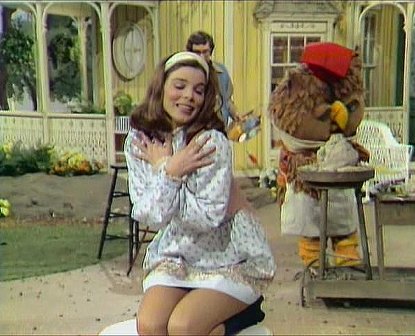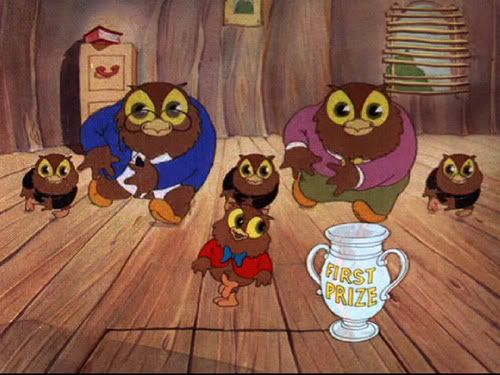Someone’s been leaving food around, and it’s attracting owls. And I, for one, am tired of cleaning out those owl traps.
Zack Snyder, The same fellow who cobbled together the overrated, gay-coded, loutish and bombastic “300,” and the overwrought superhero epic “Watchmen,” has recently directed an animated action film about warlike tribes of owls called “Legend of the Guadians: The Owls of Ga’Hoole.” At the news, I was partially fascinated (part of my brain felt that this film could resemble a Jim Henson film), and partially weary (really? Owls?) But even before I could finish rolling my eyes, the thought occurred to me that owls have been flying around my subconscious for years.
I, your trusty pop culture naturalist, donned my khaki shorts and my pith helmet, and took to the field with my notebook and my binoculars to compile the following journal of the owl in films, TV, comics and video games. I have dissected the owl pellets, and reconstructed the following rodent skeletons. I admit that what I just wrote was a weirs metaphor.
Without further ado, lets nuzzle into this set of hooters.
Woodsy Owl
from the USFS safety commercials (1970-present)
hootus pullutus

This is a rare species of owl found in littered parts of North American forests. Large and box-like in appearance, Woodsy appears to be flightless. Woodsy appears to children, and offers advice in the form of catchy rhyming slogans like “Give a hoot! Don’t pollute!” The children always, without fail, take his advice.
Woodsy is clearly an ally or adjunct, or perhaps just a direct imitation of Smokey the Bear, whose confrontational slogan “Only YOU can prevent forest fires” was actually effective in curtailing the number of accidental wildfires in wooded areas. But whereas Smokey was stern and threatening, Woodsy appears to be wacky and flightly and even kind of goofy. It’s a good idea not to litter, but Woodsy lives for litter. What a surreal life he must lead.
In 2006, Woodsy was either replaced by an heir, or went through a dramatic molting process, as he appears differently now, and even has a new slogan: “Lend a hand! Care for the Land!” I prefer the old boxy Woodsy.
Mr. Owl
from the Tootsie Pop commercial (1970)
cornu syruppia

Ostensibly wise – he wears a mortarboard – this greedy bastard lives on the candy stolen from curious children.
Well, the only appearance of this rare breed of bird was on a recurring television commercial for Tootsie Roll’s Tootsie Pops. A young boy approached an elderly turtle with an absurd philosophical dilemma. Perhaps it was a complex metaphor for some oblique political issue, or perhaps a Zarathustrian flight of poetic fancy, but the boy asked the turtle how many licks it would take to reach the Tootsie Roll center of a Tootsie pop. The turtle proclaims that he does not know, as he has always bitten through the hard candy shell. The turtle recommends that the boy ask Mr. Owl. Mr. Owl is eager to help, and decides to use the scientific approach to the dilemma by licking the Tootsie Pop himself. He counts three of his licks before he – perhaps unconsciously – bites the candy and swallows it whole. He returns the candy stick to the boy, and the boy leaves dejected.
Like a protracted fable by Aesop, this commercial bore its way into the minds of a generation, and kids, to this day, wrestle with the boy’s odd philosophical dilemma, and must face Mr. Owl’s cruel Satyricon.
The Great Owl
from “The Secret of NIMH” (1982)
creepi as heckus

The rats of NIMH are an interesting specimen in and of themselves, as they are a race of intelligent rodents with language and a working familial society. But, always present in their imaginations, like a aristocratic philosopher king, the rats had an ersatz ruler in the form of the gigantic and terrifying Great Owl. Rats would brave the forbidding knotted tree fortress of the Great Owl, risk being eaten, and ask for advice. The Great Owl would scowl, and offer cryptic riddles and harsh observations to aid the rats in the most rudimentary possibly fashion, then take to the sky to hunt the rat’s brethren.
Few children who managed to see this owl escaped the scenes without being utterly terrified, and perhaps kept off balance by the odd advice given. The Great Owl speaks with the voice of John Carradine.
Bubo
from “Clash of the Titans” (1981)
Bubo bubo

Bubo is the only one of its species, as it was created by a divine being.
Desmond Davis was a film director who chronicled the adventures of Perseus, and his clash with Zeus, Hades, and a gigantic kraken. Along his many adventures, Perseus (Harry Hamlin) is aided by the Gods of Olympus in varying ways, the most notable of which was a mechanical owl Bubo, constructed by Hephaestus, and fashioned after the divine owl owned by Athena. Bubo was a cute little bugger who would hoot and squeal more often than offer any practical help. To be fair, Bubo did lead Perseus to the home of the Stygian witches.
Bubo is also a resilient little machine owl, as, in 2010, he managed to appear on the big screen again, albeit briefly, to help a new Perseus (Sam Worthington) clash with some new Titans. Story goes that Sam Worthington hated Bubo, and threatened to leave the film if Bubo was anywhere near a running camera. Bubo, tenacious little bird that he is, managed to remain.
Storm Owl
from “Mega Man X4” (1998)
Hooti sigma

The Storm Owl, like Bubo before it, is actually a robotic creature possessed of artificial intelligence. But whereas Bubo was intended to help, the Storm Owl was created to destroy you. Part of an evil army of robots led by wicked android lord Sigma, the Storm Owl was built for battle, equipped with air blowers, lasers, and an ability to cause storms. In video game parlance, the ability to start storms may be commonplace, but that damn Owl managed to make it all the more difficult.
In my research, I found the need to destroy the Owl, and steal its power. I always did well with the early “Mega Man” adventures, but as the games progressed, they became more and more difficult and oblique, until, by “Mega Man X5,” I wasn’t even fighting real animals anymore. What’s a Spike Rosered?
Some may complain that the Storm Owl was a bland knockoff of “Mega Man X’s” Storm Eagle. This is a valid argument, so I will only defend by saying that the Owl was more interesting to look at, and was harder to defeat. Plus, it has the advantage of not being associated with something called a Kuwanger.
Larry King
from “Larry King Live” (1985 – present)
Caller goaheadus

This flightless, featherless species of North American owl, fond of suspenders, and possessed of a protracted sense of humor, has been masquerading as a man since the mid 1950s when he started appearing on Florida radio stations an interviewer. Preferring to hunt at night the King Owl would appear on late night call-in radio programs, starting in 1978. By 1985, the King Owl had achieved media clout, and began appearing on a call-in interview CNN program.
The King Owl prefers multiple mates, and has claimed seven mates in his life. When not on television, The King Owl roots in the the rafters of the television studio, where he preens, and plucks eider down from his abdomen.
Charlie Owl
from “The New Zoo Revue” (1972-1977)
Costumus baggius

Unseen for decades, Charlie Owl became the archetypal owl for a generation of children. He was friends with two humans, Doug and Emmy Jo (Doug Momary and Emily Peden), who would sing and dance, and talk to the creatures of the woods. While Henrietta Hippo and Freddie the Frog were fun-loving types, eager to play games, Charlie was a dour and serious soul, who refused to joke, and took his status as the group’s intellect very seriously. He also wore a mortarboard, which seemed to be common amongst many species of pop culture owls. He was an inventor by trade, and even had an elevator equipped in his tree.
Charlie the Owl faded into obscurity, and I have not observed him for many years. It is rumored that co-star Chuck Woolery arranged a job for him as an associate producer on “Wheel of Fortune,” but this is unsubstantiated. Charlie is endangered, presumed extinct.
Hooters Girls
from Hooters Restaurants (1983 -present)
Buffalowing leanoverus

Hooters Owls provide several distinct services to the average, overweight, lecherous American male. They bring in a steady stream of crappy buffalo wings and deep fried pickles chips, they offer a delightfully un-challenging menu of greasy American standards, and they are invariably possessed of exactly the kind of body that readers of Maxim are so fond of.
Hooters kind of baffles me. How is it they can get away with so transparent a name? Is it only because “Fuddruckers” was taken? Can you really be fired as a Hooters Girl if you gain too much weight? Do the women have to write their measurements on their job applications? And is the promise of a hot woman in bright orange short shorts and a tight, tight white t-shirt really enough of a draw to brave the crappy food? Perhaps it is. Hooters tries to deflect their obvious lecherous interests by sponsoring numerous charities and gold tournaments, and encouraging athletics. I think we all know what’s really involved.
All I know is, thanks to these famous sexy birds, men all over the country have wanted to have sex with owls.
Owlman
from DC comics (1964, 1990)
superhero nihilus

Originally orchestrated to be a Batman villain (as owls feed on bats), Owlman was kind of a forgettable DC character. However, in the 1990s, DC repurposed the character for great effect: In a parallel universe, there is no Bruce Wayne, but only Bruce’s older brother Thomas who, when he saw Bruce get killed, became the superhero vigilante Owlman. He is essentially the same as Batman, lurking about in shadows, eluding the police, and scheming against him enemies, although in this universe, he works for a powerful superhero syndicate.
Owlman has gone through several incarnations over the decades, but his most recent seems to be the most interesting to me. Evidently, in “Justice League: Crisis on Two Earths,” the ordinary DC superheros find themselves in a parallel universe, fighting their doppelgangers. Owlman is played by James Woods, and, very practically, seems to have an existential crisis when he learns of the parallel universe. Why do anything if there’s another version of you doing similar, and even better, things in a parallel universe. It takes away your uniqueness. Owlman then goes on a crusade to make sure he is the only Owlman out there, and builds a device called the QED. Look out Nite Owl. Aside from Thanos in the Marvel universe, I can’t think of many other supercharacters that are out-and-out nihilists.
Owl Jolson
from “I Love to Singa” (1936)
Jazzi mammius

Music Professor Fritz Owl eagerly awaits the hatching of his owlets, eager to teach them music, and see was talents they have. He is stringently anti-jazz, feeling that it it’s all too hotcha for him. Too pop. All of Fritz’s owlets hatch literally playing instruments, or singing beautiful baritone arias. One of his chicks, though, Owl Jolson, hatches singing jazz. “I love to singa! About the moona and the June-a and the springa,” he sings. Fritz is very upset, and tries to get him to sing ballads, but Jolson will have none of it. Owl Jolson ends up running away from his oppressive father to audition for Jack Bunny. Eventually, when Fritz sees how much Bunny loves him, returns to his side, and comes to terms with his son’s jazz-singing ways.
This was one of Tex Avery’s earliest cartoons, and seamlessly riffed on the careers of Al Jolson, not only following the story (kind of) of the revolutionary “The Jazz Singer” (1927), but took its central song, from Jolson’s “The Singing Kid” (1936).
In addition to riffing on jazz conceits, and giving those of my generation a classic jazz education, this is a hilarious cartoon, that is slightly more anarchic than the Warner Bros. Cartoons that preceded it. Avery established himself as a creative force in the cartoon world with this film. The cartoon also experienced new life in the first episode of “South Park,” when space aliens landed in the titular town, and transformed people into performing jazz singers.
Where is Owl Jolson today? Still enjoying life in reruns. You can even watch the cartoon here:
Witney Seibold is a writer living in his own little world. He’s been known to write weird articles on owls from time to time. He can, however, write film reviews, essays, and maintain a Series project. For his more sane stuff, visit his movie review ‘blog: http://witneyman.wordpress.com/